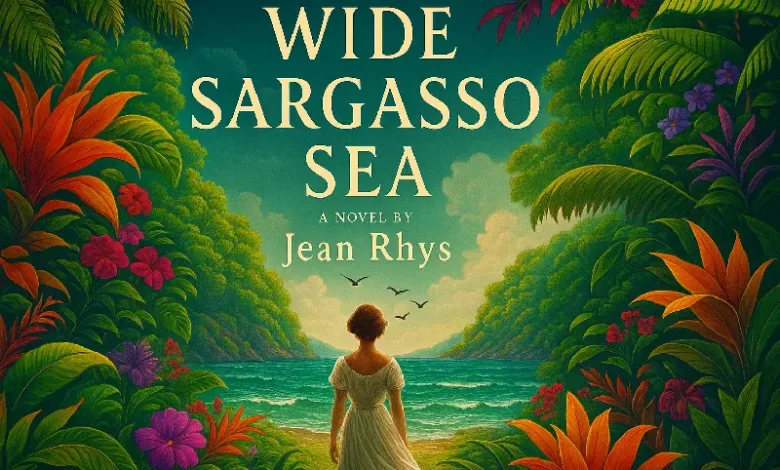Wide Sargasso Sea

Wide Sargasso Sea is the most celebrated novel by Jean Rhys, published in 1966, and widely regarded as a classic of postcolonial literature. Serving as a prequel to Charlotte Brontë’s Jane Eyre, the novel reimagines the life of Bertha Mason, the infamous “madwoman in the attic,” offering a powerful exploration of identity, colonialism, race, and gender through a Caribbean lens.
Origins and Purpose of Wide Sargasso Sea
Jean Rhys, born in Roseau, Dominica, grew up in a colonial environment that profoundly shaped her understanding of racial and cultural complexities. In Jane Eyre, Bertha Mason is depicted as a monstrous figure without history or voice. Rhys, deeply uncomfortable with this portrayal, set out to give Bertha, renamed Antoinette Cosway in her novel,a story, a background, and a humanity.
Wide Sargasso Sea emerged from Rhys’s desire to challenge and complicate the colonial narratives of the 19th century, particularly those that marginalised Creole women and distorted Caribbean realities. Published after a long period of Rhys’s literary obscurity, the novel immediately established her as a significant literary figure.
Plot Overview
Set in the early 19th century, primarily in Jamaica and Dominica, Wide Sargasso Sea follows the life of Antoinette Cosway, a white Creole heiress living in the post-emancipation Caribbean. After the death of her father, a former slave owner, Antoinette and her mother fall into poverty and isolation.
Following a brief marriage arranged by her stepfather, Antoinette becomes the wife of an unnamed Englishman, widely understood to be Edward Rochester from Jane Eyre. Their relationship quickly deteriorates as mistrust, cultural misunderstandings, and racial prejudices destroy any possibility of happiness.
Manipulated by figures like the scheming Amélie and poisoned by colonial and racial anxieties, the Englishman renames Antoinette as “Bertha,” stripping her of her identity. Eventually, he removes her from the Caribbean and confines her in England, where her spirit breaks under isolation and loss.
Narrative Structure and Style
Wide Sargasso Sea employs a fragmented and shifting narrative structure, alternating between the perspectives of Antoinette and her husband. This technique reflects the psychological fragmentation experienced by the characters and offers multiple views on events, emphasising themes of misunderstanding and alienation.
Rhys’s lush, poetic prose captures the beauty and menace of the Caribbean landscape, rendering the island setting not merely as background, but as an active, almost oppressive force within the novel.
Major Themes
Wide Sargasso Sea is dense with thematic complexity, offering a rich critique of colonialism, gender dynamics, and identity formation.
Colonialism and Its Aftermath
Set during the turbulent post-emancipation period, the novel portrays the crumbling colonial order and the deep social scars left by slavery. The Cosway family’s fall from wealth reflects the broader collapse of the white planter class, and the tensions between former slaves and former slave owners pervade the story.
The Englishman’s inability to understand or respect Antoinette’s Caribbean world highlights the imperialist arrogance that destroyed not only societies but individual lives.
Identity and Alienation
Antoinette’s struggle to maintain her sense of self under the pressures of racial, cultural, and gendered expectations is the emotional core of the novel. Forced into an identity constructed by others, as “Bertha”, she loses her voice, autonomy, and sanity.
Jean Rhys powerfully depicts how colonialism and patriarchy combine to erase and distort the identities of marginalised individuals.
Race, Class, and Gender
Antoinette’s status as a white Creole woman places her precariously between racial and social categories. She is neither entirely accepted by the Black community nor by the European colonisers. This in-betweenness mirrors the liminal experiences of many postcolonial subjects, who are trapped between worlds without truly belonging to either.
Gender oppression compounds Antoinette’s vulnerability. Her fate is primarily controlled by male figures, her stepfather, her husband, and colonial structures, all of whom diminish and eventually destroy her agency.
Wide Sargasso Sea and Dominica
Although most of the novel is set in Jamaica, Dominica’s lush landscapes, social structures, and cultural tensions significantly inform its emotional and symbolic power. Jean Rhys’s Dominican upbringing gives the novel its vivid authenticity, from the intense descriptions of tropical flora to the psychological weight of colonial society.
Rhys’s intimate knowledge of Caribbean life allows her to capture the alienation and beauty of the islands without exoticising them, offering a rare insider’s perspective in a literary world often dominated by European gazes.
Critical Reception and Legacy
Wide Sargasso Sea was met with widespread critical acclaim upon its publication. It won the WH Smith Literary Award in 1967 and is now considered a foundational text in postcolonial literary studies.
The novel’s impact is far-reaching:
- It challenged readers to reconsider canonical works like Jane Eyre through a postcolonial and feminist lens.
- It brought Caribbean perspectives into mainstream English literature.
- It influenced subsequent writers dealing with colonial legacies, such as Jamaica Kincaid and Edwidge Danticat.
The academic study of Wide Sargasso Sea spans disciplines such as literature, postcolonial theory, gender studies, and Caribbean history. The novel remains a staple of university curricula worldwide.
Adaptations
Wide Sargasso Sea has been adapted several times:
- A 1993 film directed by John Duigan, though criticised for simplifying the novel’s complexities.
- A 2006 BBC television adaptation was praised for its more faithful depiction of Rhys’s nuanced portrayal of Antoinette.
These adaptations have helped sustain and expand public interest in Rhys’s work, introducing new generations to the story of Antoinette Cosway.
Enduring Importance
Today, Wide Sargasso Sea continues to resonate because it speaks to enduring questions about power, identity, and historical injustice. Rhys’s compassionate yet unflinching portrayal of Antoinette compels readers to confront the human cost of empire and the devastating consequences of cultural erasure.
The novel also highlights the enduring strength of Caribbean literature in the global scene. By giving voice to a silenced character from a famous English novel, Rhys reclaims space for the Caribbean experience in the literary canon.
Her achievement with Wide Sargasso Sea remains an extraordinary example of how marginalised perspectives can transform and enrich world literature.




